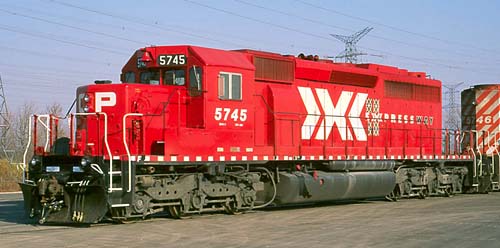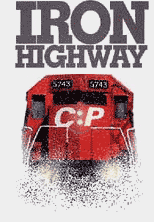|
Intermodal's "Shining Star"

Canadian Pacific SD40-2 number 5745 at Hornby, Ontario - Oct 1999 Brian D.
Switzer.
 CPR's Expressway service offers radically different ralationship with truckers.
CPR's Expressway service offers radically different ralationship with truckers.
In certain markets such as Montreal-Toronto-Detroit, trailers continue to dominate. That's where Expressway fits the bill. At first glance, it is the one
product that resembles the CPR's first trailer-on-flatcar trains. But appearances can be deceptive. Under the skin, Expressway is radically different.
"Piggyback largely competed head-to-head with the truckers, but we don't," says Paul Gilmore, vice-president of Expressway. "The truckers, not
the CPR, solicit the business". By not going head-to-head, we can offer savings and service improvements that benefit us, the truckers, and the shippers.
We only have to invest in the rail cars and the terminals to provide a pure line-haul service.
Getting Traffic Off the Highways
"Over-the-road truckers and private fleet operators like Hudson's Bay Company and Frito-Lay can avoid driver shortages and reduce their investment by only
buying tractors for the local pick-up and delivery from our terminals. Working together, we're improving service, cutting costs, and getting traffic back off
the highways."
Expressway has increased from 25,000 to 85,000 trailers annually in just two years. Automotive parts, which must move reliably on a just-in-time basis in both
directions between Ontario and Michigan, have shifted to rail dramatically in the wake of 11 Sep 2001. The border has become a choke point for truckers. No
Expressway train has ever been delayed significantly for customs clearance.
Traffic growth and an extension to Chicago are on the horizon. Paul has met with government officials who'd like to see Expressway operating in their states.
He adds, "We're regularly running trains with 75 or 80 cars, twice daily on both segments of the route, with a fleet of 310 platforms. Customers tell us
they can give us more business if we add frequencies, especially between Toronto and Montreal. But we are pushing the physical limits of that corridor now. If
we are successful in getting governments at all levels to come on board in a public/private partnership (P3) that benefits all the users and the public, then
it will happen."
P3s are rail-based partnerships that require the benefit of government investment as a catalyst to implementing new services that are in the public interest.
As CPR president Rob Ritchie has pointed out, these P3 programs are the key to unleashing the full potential of the railway. Intermodal is obviously a large
part of that potential.
"Intermodal is really the CPR's shining star and it's got a solid future," Paul says. "Our predecessors knew what they were doing when, they
started it rolling 50 years ago.
|